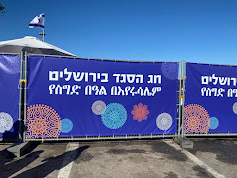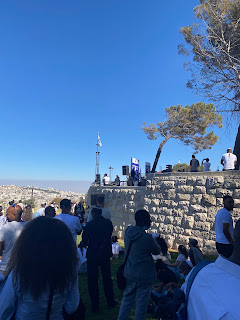Dabo Bread and Dancing at Bus Stops: Highlights From an Inspiring Sigd
An outpouring of culture, custom, and collectivism, this past Thursday’s Sigd celebration filled me with awe and admiration. Vast crowds of Ethiopian-Jews gathered together on the Jerusalem Tayelet to celebrate connection and yearning to reside in Jerusalem, a reality that was made possible for thousands of Ethiopian families, who endured strenuous travels and obstacles, in the past few decades.
The unique customs and practices of Ethiopian Jewry shine a light on
how incredible it is to have maintained tradition and devoutness throughout the
diaspora. After the opening ceremony of the event, in which politicians
addressed the feats and accomplishments of the community, I met a friendly young
man named Oded. After offering my friends and I to taste some of his Dabo, a
traditional Ethiopian bread that many Ethiopian Jews serve on Shabbat and that
many break their Sigd fast with, he explained with eagerness his mom’s
commitment to Judaism and gratitude to be in Jerusalem. His parents, he told us,
immigrated to Israel in Operation Moses, and ingrained in him the importance of
tradition which they had maintained while growing up in Ethiopia.
When walking
down the Tayelet, various booths were up selling books, literature, and
memorabilia targeted at Ethiopian-Jewish customs. Almost all the books were in
Amharic, which further emphasized to me the community’s unique ability to
maintain identity from their homeland whilst integrating into Israeli society. I
saw this same commitment at another booth in which two women sold a children’s
educational card game with pictures on one side and the word for the picture in
both Amharic and Hebrew on the other. Language is one of the key unifiers and
preservers of culture. By committing to educating children in Amharic and
Hebrew, these Ethiopian Olim dedicate themselves to maintain the Jewish and
Ethiopian cultures. In a society where traditional Judaism is constantly
challenged by technology and development, and where the clash between universalism and particularism characterize Judaism, I am inspired by the Ethiopian Jewry
who are able to simultaneously maintain tradition and to integrate.
There is no
better ice-breaker than food, and indeed this held true again when meeting
Brhan, an Ethiopian-Israeli young woman currently studying at Ben Gurion
University. The second person to offer us some Dabo, we gladly accepted and
quickly got to bonding and talking. She told us she speaks Amharic at home,
which you would never guess because of how flawless her English and Hebrew are,
and that her name means “dawn” in Amharic, which her dad chose because he loves
sunsets. She passionately spoke to us about Ethiopian customs and traditions,
both religious ones and cultural ones. One that particularly stood out was her
explaining that many Ethiopian-Israeli families keep pets and dogs because in
Ethiopia their parents and grandparents were shepherds and tended to animals,
and this aptitude towards animals remained intact.
One of the ceremony's
practices that draws the most attention is the blessings of the Kessim, the
Ethiopian- Jewish religious leaders. Brhan explained to me that they act in ways
similar to Rabbis, but deal with more intimate matters such as household
disputes and interpersonal arguments. They spend many years studying, and each
Ethiopian Jewish family can choose their own Kess that they go to for guidance
and advice. They were distinguishable at the Sigd through their elegant gowns
and highly adorned and embellished umbrellas. People of all ages were going up
to them and receiving blessings from them, a phenomena I found touching as the
relationship of the Kessim to the community signals a relationship transcending
religion and reaching points of deep history and tradition. Among the advocates for the Kessim in Israeli society is Rabbi Dr. Sharon Shalom, who I got a chance to very briefly meet on
the way out of the Sigd ceremony.
The significance and enthusiasm evoked by this
holiday didn’t stop at the Tayelet, however. At the bus stop after the ceremony,
a group of young Ethiopian- Israelis were playing traditional Ethiopian music
while dancing and celebrating. A little hesitant and scared but eager to join in
on the spontaneous bus-stop-celebrating, I began dancing with them. They became
ecstatic and started dancing and signing with me, showing me classic dance moves
from their culture. The sheer excitement and energy I felt at the bus stop
showed me the value of a multicultural society. When we got on the bus, we got to
talking with one of the bus-stop dancers, Itafu, who told us about his
experience as a lone soldier who came to Israel in 2009, inspired by the
“kibbutz galuyot” or ingathering of exiles promise of the bible. Israel’s
attraction to Jews from around the world is essentially what has outlined Israeli
society. While a unified and distinct Israeli culture has shaped throughout its
short life, the Sigd holiday exposed to me that within this culture exists a
plethora of practices and traditions that are unique to the different groups and
that make Israel Israel.
Written by Abigail Leibowitz



Comments
Post a Comment